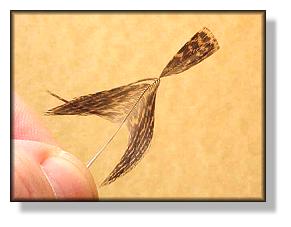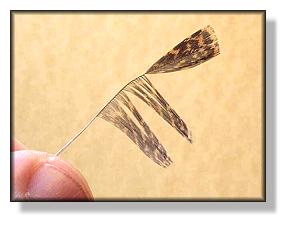Almost every fly tying book you pick up which shows a method for preparing a soft
hackle feather will show it done thus.

The instruction will now go on to instruct you to tie in the feather by the tip, concave side
toward the rear, and wrap as you fold the hackle to the rear. Using 1-1/2 wraps will yield a
delicately dressed fly, which is the object of the exercise. Some books go on to specify three
wraps, which results in a terribly over dressed fly.
Now, there are a couple of problems with the method presented.
1, folding and wrapping can be a bit tricky, particularly for the new tier, it is also a distraction we can
all do without.
2. the 1-1/2 turns of the hackle would require that we either tie in the hackle, or tie it off, on the top of the
hank. The temptation to take an extra half wrap, thus adding more hackle when the object is a sparse
delicacy is also unacceptable.
3, It is as mentioned more difficult to do all of that folding and stroking as the instructions require.
The ages only know the identity of the tier who solved both of these problems with this, the simplest
of techniques.
Prepare your feather as before, stroking the barbules toward the rear, leaving a small bunch at the tip
for tying onto the hook.
Now, and this is the neat part, with the concave side of the feather away from you, strip all of the hackle
on the left side below the tie in at the tip from the stem. You should now have a feather with barbules
on the right side only.

Next, tie in your feather as before, by the tip, from underneath of the shank. Take three turns with
the concave side of the feather toward the rear, if you really must, take a fourth turn, but don't over
do this, these flies are intended to have sparseness to them. Tie off the hackle, again underneath
of the shank.
Dry flies require many more turns of hackle than do wets and soft hackle types. We could speculate
that the tendency to "over dress" these flies has it's origins with the dry fly. This technique allows
us to take a fair number of turns, like we are accustomed to doing, without adding as much bulk per turn.
We have also eliminated entirely that darned stroking of the feathers to the rear with each turn
around the hook.
This method is easier, faster, and yields a fly of better quality than is possible with the conventional
methods, it is just plain easier to control the material.
Try it, you will never tie a soft hackle or a wet fly collar the "traditional" way again, bet on it!
In a future tying tip we will demonstrate a method for those of you who, bound by the ties of tradition,
will not commit sacrilege by using this technique, we will simply improve the method of folding
your hackle.
If you have any tips or techniques, send them along, most of this
material has been stolen from somebody, might as well steal your ideas
too!~ George E. Emanuel
(Chat Room Host Muddler)
|


